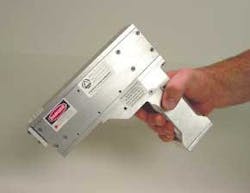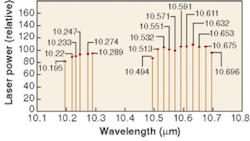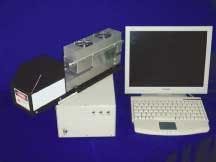YONG ZHANG, MICHAEL ADAMS, ADAM CHACE, JOHN GEAREY, and NATHANIEL CHE MCDONALD
We have come a long way since the days of van-sized carbon dioxide (CO2) lasers, thanks to the commercial deployment of radio-frequency (RF) excitation in the years since the 1980s. Even so, most people picture CO2 lasers as bulky devices that are found in industrial settings and used for their raw power, performing tasks such as cutting and drilling. Another aspect of the CO2 laser—its precise and densely populated spectral lines—has not been widely exploited, mostly because of the lack of commercially viable laser sources that take advantage of these fine spectral features pre-ordained by nature.
This situation is rapidly changing with the recent advent and development of miniaturized RF-excited CO2 lasers. Portable, low in cost, stable, tunable, and requiring only air cooling, these lasers offer great flexibility as high-spectral-purity sources for a new generation of analytical instruments and other devices. A compact CO2 laser can be integrated into a commercial package with data collection and analysis, electronic control and display, sample dispensing if necessary, and other capabilities. For many years, lasers incorporating these analytical functions required large optical benches and cooling by cumbersome water chillers; now, desktop and portable models are feasible (see Fig. 1).
Applications in spectroscopy
Carbon dioxide emission lines suitable for laser operation span the 9.2- to 10.8-µm wavelength range. A rich array of combinations of isotopes of carbon and oxygen produces another 17 molecular species—a total of 18 sets of unique spectral lines. With 80 to 150 lines to every species, these isotope molecules fill in each others' spectral gaps, and extend the ends of the spectral range to 9 and 12 µm.1 This wavelength range, usually referred to as long-wave infrared (LWIR), is also populated by signature absorptions of many inorganic and organic gases and many solid-state, liquid, inorganic, and polymer materials.2
Many analytical instruments that aim to detect and quantify the existence of minute amounts of gas are based on LWIR laser spectroscopy, which has benefited from years of accumulated experience and data from laboratories around the world. Several spectral-analysis techniques have been developed to detect trace amount of gases: photo-acoustic spectroscopy, differential-absorption spectroscopy, optogalvanic spectroscopy, cavity-ringdown spectroscopy, integrated-cavity-output spectroscopy, and so on. Some of these have been commercialized, some are going through the commercial-prototype stage, and some are still under development.
Photo-acoustic spectroscopy is used for trace-gas analysis and close-range (hundreds of meters or less) remote sensing.3, 4 Some commercial systems have already reached a practical sensitivity of 300 parts per trillion for measurement times of less than 10 seconds. Applications include industrial process control, agriculture process monitoring, medical diagnostics, chemical-weapon-agent sensing, leakage detection, and others.
Differential-absorption spectroscopy is useful for stand-off or sample-and-test trace-gas sensing of chemical-weapon agents and in industrial process control.5 Optogalvanic spectroscopy is suitable for gas detection and analysis (for example, in breath analysis of isotope-labeled carbon dioxide for diagnosing a variety of gastrointestinal disorders), environmental monitoring, and other applications.6 Continuous-wave cavity-ringdown spectroscopy is used in a portable system for high-altitude in-flight monitoring of trace gases in the atmosphere, especially ozone.7
We call these applications high-finesse applications (HFAs) because, unlike the traditional industrial applications such as cutting, drilling, and marking, in which it is most important for the CO2 laser to deliver raw power, the abovementioned applications require the laser to be wavelength-stable, wavelength-tunable, and power-stable, in addition to being compact in size.
Stability and tunability
Typical CO2 lasers with stable resonator designs go through a process called "line-hop" during their entire period of operation, which in the past has prevented them from meeting HFA requirements; the shorter the laser resonator, the more pronounced this problem is. Carbon dioxide lasers with unstable resonators have a fluctuating broadband spectrum with a multiline output at all times, making them even less attractive for HFA. The line-hop results from the uncontrolled dimensional fluctuation of the optical resonator, which for most industrial lasers is based on an aluminum structure. These random fluctuations are caused by the constant change of parameters of the ambient thermal environment, such as temperature, humidity, and the amount and direction of air flow. The optical frequencies of the longitudinal modes of the resonator are related to its length as:
ƒN = NC/2L
where ƒN is the frequency of the Nth mode of the resonator, C is the speed of light, and L is the length of the laser resonator. As L changes, it causes the frequency of every mode of the resonator to drift, leading to the deviation of their overlap with the laser's gain spectrum. This causes the laser to hop from one spectral line to another because only the overlap point with the highest gain will oscillate. For a laser resonator that is 5 in. (127 mm) long, the laser will jump a line every time the cavity length changes by approximately 0.3 µm. The spectral spacing f between adjacent longitudinal modes is given by:
ƒ = C/2L
This tells us that, within a given frequency range, there are fewer modes for a shorter cavity because the mode spacing is greater. For a given gain spectral distribution (which is determined by the working gas mixture and conditions of excitation), this leads to a lower probability of optimum overlap, and therefore a greater likelihood of power fluctuation and line-hop.
By using low-thermal-expansion material, such as Invar or specialty carbon fiber, to support the resonator, and maintaining a stable thermal-mechanical environment by proper temperature regulation as the laser self-heats, the resonator dimensions can be very well controlled with minimum extra cost. This results in very good wavelength and power stability in lasers with very short resonators. The passive long-term power fluctuation can be held at less than ±1% over hours of operation and the frequency maintained within a few megahertz. This level of stability is good enough for a majority of HFAs. Active resonator-length control with a feedback loop can be added with piezoelectric actuators to achieve even better stability.
With the resonator length under control, the line-hop phenomenon becomes an advantage. Stabilized lasers can also be wavelength-tunable through deliberate temperature adjustments. By fine-tuning the Fabry-Perot etalon that is the laser resonator itself, one can choose among more than ten lines over a spectral range of 0.4 µm (see Fig. 2). These gratingless tunable lasers are lower-cost alternatives to grating-tuned lasers for applications that do not require a large wavelength range, and they avoid the degradation in laser efficiency caused by an intracavity tuning grating.More applications
The wavelength, high optical power, portability, low cost, and ruggedness of compact CO2 lasers lends them naturally to illumination for thermal-vision devices (which operate over a 8- to 12-µm wavelength range). These devices are widely used in defense and national security, mostly in mobile settings. Thermal-vision devices have become readily available as their prices have dropped precipitously over the last decade. Used as a pointer or designator, a miniature laser can be mounted as an integral part of a thermal-vision device, sharing its 12-V power supply. The long coherence length and stable tunable wavelength of compact CO2 lasers has also been useful in IR interferometry, characterization, and testing of IR optics and photonic crystals.8Because the wavelength of the CO2 laser is absorbed well by glass, these portable lasers can be incorporated into small devices to process optical fiber. A laser power of about 1 W, when focused, will readily melt a 150-µm-diameter single-mode optical fiber. Even traditional industrial and surgical environments can benefit from a device that is compact and flexible. Some compact laser models can be "super pulsed" to greater than 20 W of peak power and a few millijoules of pulse energy. This feature allows a 1-ft-long laser to process hard materials such as glass and ceramic. Portable laser-based devices that, when linked to standard personal computers for control, can mark, engrave, and cut a wide variety of materials are a natural outcome of this development (see Fig. 3). We also expect to see the appearance of portable surgical devices and portable devices for medical therapy.
REFERENCES
- C. Freed, The Lincoln Lab. J. 3(3) 479 (1990).
- NIST Web site: http://webbook.nist.gov.
- M. B. Pushkarsky et al., Appl. Phys. B (2002), Published online, Aug. 21, 2002.
- R. A. Meyers et al., Ed., Encyclopedia of Analytical Chemistry, Applications, Theory And Instrumentation, (John Wiley & sons, Ltd), 2203, (January 2002).
- D. Cohn et al., SPIE Proc. 2118, 72 (1994).
- D. Murnick et al., Science 263, 945 (1994).
- J. B. Paul et al., SPIE 4577, 1, (2001).
- C. Lin et al., SPIE Conf. on Defense and Security (April 12, 2004; Orlando, FL.).
Yong Zhang is president and chief scientist, Michael Adams, Adam Chace, and John Gearey are laser engineers, and Nathaniel Che McDonald is manufacturing manager at Access Laser Company, 5603 47th Ave. NE, Unit B, Marysville, WA 98270; e-mail: [email protected].


